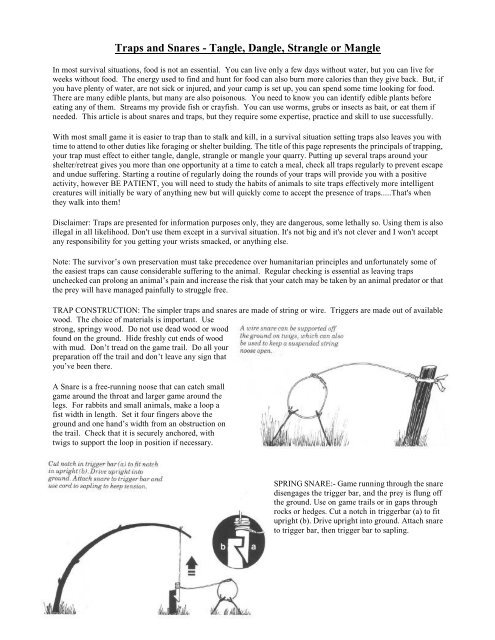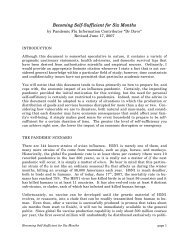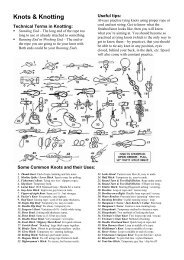Traps and Snares - Tangle, Dangle, Strangle or Mangle
Traps and Snares - Tangle, Dangle, Strangle or Mangle
Traps and Snares - Tangle, Dangle, Strangle or Mangle
Create successful ePaper yourself
Turn your PDF publications into a flip-book with our unique Google optimized e-Paper software.
<strong>Traps</strong> <strong>and</strong> <strong>Snares</strong> - <strong>Tangle</strong>, <strong>Dangle</strong>, <strong>Strangle</strong> <strong>or</strong> <strong>Mangle</strong><br />
In most survival situations, food is not an essential. You can live only a few days without water, but you can live f<strong>or</strong><br />
weeks without food. The energy used to find <strong>and</strong> hunt f<strong>or</strong> food can also burn m<strong>or</strong>e cal<strong>or</strong>ies than they give back. But, if<br />
you have plenty of water, are not sick <strong>or</strong> injured, <strong>and</strong> your camp is set up, you can spend some time looking f<strong>or</strong> food.<br />
There are many edible plants, but many are also poisonous. You need to know you can identify edible plants bef<strong>or</strong>e<br />
eating any of them. Streams my provide fish <strong>or</strong> crayfish. You can use w<strong>or</strong>ms, grubs <strong>or</strong> insects as bait, <strong>or</strong> eat them if<br />
needed. This article is about snares <strong>and</strong> traps, but they require some expertise, practice <strong>and</strong> skill to use successfully.<br />
With most small game it is easier to trap than to stalk <strong>and</strong> kill, in a survival situation setting traps also leaves you with<br />
time to attend to other duties like f<strong>or</strong>aging <strong>or</strong> shelter building. The title of this page represents the principals of trapping,<br />
your trap must effect to either tangle, dangle, strangle <strong>or</strong> mangle your quarry. Putting up several traps around your<br />
shelter/retreat gives you m<strong>or</strong>e than one opp<strong>or</strong>tunity at a time to catch a meal, check all traps regularly to prevent escape<br />
<strong>and</strong> undue suffering. Starting a routine of regularly doing the rounds of your traps will provide you with a positive<br />
activity, however BE PATIENT, you will need to study the habits of animals to site traps effectively m<strong>or</strong>e intelligent<br />
creatures will initially be wary of anything new but will quickly come to accept the presence of traps.....That's when<br />
they walk into them!<br />
Disclaimer: <strong>Traps</strong> are presented f<strong>or</strong> inf<strong>or</strong>mation purposes only, they are dangerous, some lethally so. Using them is also<br />
illegal in all likelihood. Don't use them except in a survival situation. It's not big <strong>and</strong> it's not clever <strong>and</strong> I won't accept<br />
any responsibility f<strong>or</strong> you getting your wrists smacked, <strong>or</strong> anything else.<br />
Note: The surviv<strong>or</strong>’s own preservation must take precedence over humanitarian principles <strong>and</strong> unf<strong>or</strong>tunately some of<br />
the easiest traps can cause considerable suffering to the animal. Regular checking is essential as leaving traps<br />
unchecked can prolong an animal’s pain <strong>and</strong> increase the risk that your catch may be taken by an animal predat<strong>or</strong> <strong>or</strong> that<br />
the prey will have managed painfully to struggle free.<br />
TRAP CONSTRUCTION: The simpler traps <strong>and</strong> snares are made of string <strong>or</strong> wire. Triggers are made out of available<br />
wood. The choice of materials is imp<strong>or</strong>tant. Use<br />
strong, springy wood. Do not use dead wood <strong>or</strong> wood<br />
found on the ground. Hide freshly cut ends of wood<br />
with mud. Don’t tread on the game trail. Do all your<br />
preparation off the trail <strong>and</strong> don’t leave any sign that<br />
you’ve been there.<br />
A Snare is a free-running noose that can catch small<br />
game around the throat <strong>and</strong> larger game around the<br />
legs. F<strong>or</strong> rabbits <strong>and</strong> small animals, make a loop a<br />
fist width in length. Set it four fingers above the<br />
ground <strong>and</strong> one h<strong>and</strong>’s width from an obstruction on<br />
the trail. Check that it is securely anch<strong>or</strong>ed, with<br />
twigs to supp<strong>or</strong>t the loop in position if necessary.<br />
SPRING SNARE:- Game running through the snare<br />
disengages the trigger bar, <strong>and</strong> the prey is flung off<br />
the ground. Use on game trails <strong>or</strong> in gaps through<br />
rocks <strong>or</strong> hedges. Cut a notch in triggerbar (a) to fit<br />
upright (b). Drive upright into ground. Attach snare<br />
to trigger bar, then trigger bar to sapling.
LEG SNARE :- Push a natural f<strong>or</strong>k <strong>or</strong> two sticks tied<br />
together into the ground. The line from a sapling is tied<br />
to a wooden toggle <strong>and</strong> the toggle passed under the<br />
f<strong>or</strong>k. When the game takes the bait, attached to a<br />
separate stick, it falls away releasing the toggle that<br />
flies up taking the snare <strong>and</strong> the game with it. Large<br />
versions are amongst the best snares <strong>or</strong> heavy game.<br />
DOUBLE SPRING SNARE:- Two saplings are notched to<br />
interlock when bent towards each other over the game trail.<br />
A vertical bait bar is lashed near the end of one of them.<br />
Two snares can be attached to each sapling, they need to be<br />
fairly stiff to hold their positions. This trap is useful in<br />
clearings to catch small carniv<strong>or</strong>es. When the bait is taken<br />
the game is help in the air between the saplings.<br />
BAITED SNARE:- Construct as f<strong>or</strong> spring snare but using<br />
the release mechanism shown. The bait supp<strong>or</strong>t should be<br />
only lightly driven into the ground as it must fly away with<br />
the snare.<br />
ROLLER SPRING SNARE:- A rounded grip<br />
holds the snare arm here, the switch line is best<br />
pulled back at a slight angle to keep it in place.<br />
Suitable f<strong>or</strong> animals such as rabbits <strong>and</strong> foxes.<br />
Although tensed in one direction, the bar will be<br />
dislodged by an animal’s struggles.
DEADFALL TRAPS: These traps all w<strong>or</strong>k on the principle that when the bait is taken a weight falls on the prey. All<br />
are good f<strong>or</strong> game such as pigs, foxes, <strong>and</strong> rodents. Larger versions can be used f<strong>or</strong> bigger animals such as dear <strong>and</strong><br />
bears. WARNING! The large versions of these deadfall traps can be extremely dangerous f<strong>or</strong> humans as well as<br />
f<strong>or</strong> the prey f<strong>or</strong> which they are intended. The toggle release <strong>and</strong> deadfall traps can easily be set off accidentally.<br />
Even in survival situations ensure that everyone knows exactly where they are. In survival practice keep people<br />
away from them <strong>and</strong> never leave such a trap set up at the end of an exercise. You cannot set a large deadfall trap<br />
on your own. Keep the mechanism to the side of the trail, well away from the dropping weight, <strong>or</strong> setting it will be too<br />
risky. Balance is critical, <strong>and</strong> you are unlikely to get it right the first time.<br />
FIGURE 4 DEADFALL :- A simple <strong>and</strong><br />
effective deadfall trap, can be made to any<br />
size. A h<strong>or</strong>izontal bait bar is balanced at right<br />
angles to an upright with a lock bar, which<br />
supp<strong>or</strong>ts a rock <strong>or</strong> other heavy weight<br />
pivoting around the tip of the upright.<br />
BALANCE LOG & SQUARE-FACE RELEASE TRAP:- The balance log is a f<strong>or</strong>ked stick, it’s ends sharpened to<br />
dislodge rapidly <strong>and</strong> one f<strong>or</strong>k suitably baited, supp<strong>or</strong>ts one end of a cross-bar, the other end of which rests on a fixed<br />
supp<strong>or</strong>t, held there by the weight of the heavy logs <strong>or</strong> rock which rest on the bar. The Square-Face Release Trap is<br />
similar, but uses a notched upright as the supp<strong>or</strong>t, the lower face of the notch squared off. Fit the cross-bar against the<br />
squared-off lower face of the bar supp<strong>or</strong>ting the weight.<br />
NOOSE STICK:- To catch birds <strong>or</strong> squirrels, tie many<br />
fine nooses close together along a stick <strong>or</strong> branch. Do<br />
not remove the animal as soon as one is caught. It<br />
will attract other birds <strong>and</strong> squirrels <strong>and</strong> soon you will<br />
have several
FIGURE 4 TRAP:- This mechanism (See Figure 4<br />
Deadfall) can be used with a ‘log cabin’ type cage,<br />
made from a pyramid of sticks tied together, which<br />
is balanced over the bait. Scatter bait around <strong>and</strong><br />
under the cage.<br />
FISH AND FISHING: Fish are a valuable food<br />
source, containing protein, vitamins <strong>and</strong> fats. All<br />
freshwater fish are edible, but some tropical ones can<br />
be dangerous. Leave any lines out overnight <strong>and</strong><br />
check on them bef<strong>or</strong>e first light. Fishing with a hook<br />
<strong>and</strong> line is the best way of fishing <strong>and</strong> should be a part<br />
of your survival kit. Hooks can be improvised from<br />
wire, pins, bones, wood <strong>and</strong> even th<strong>or</strong>ns.<br />
RUNNING NOOSE:- A noose attached to a long<br />
pole is an effective way of pulling roosting birds<br />
down from lower branches. Sneak up in nights<br />
where there is sufficient light to see them. Slip the<br />
noose over the bird <strong>and</strong> pull, tightening the noose<br />
<strong>and</strong> pulling the bird down at the same time.<br />
Bait native to the fishes’ own water is most likely to be taken: berries that overhang it, insects that breed in <strong>and</strong> near it,<br />
parts of a fish, ants, w<strong>or</strong>ms, grubs, <strong>and</strong> other insects. Once you catch a fish, examine its stomach contents to see what it<br />
has been feeding on. I also add a few tied flies to my<br />
kit to use as well.<br />
FISH TRAPS:- You can make a wide variety of traps<br />
from ones across an entire stream to drive fish into, to<br />
bottle traps to catch small fish in. (Arrows indicate<br />
current.) If you have a plastic bottle you can make an<br />
efficient trap f<strong>or</strong> small fish by cutting it off just below<br />
the neck <strong>and</strong> then inverting the neck inside the bottle.<br />
Fish swim in but cannot find their way out again. Bait<br />
the trap to entice them in. You may also need to weight<br />
it down so it doesn’t float away.<br />
SPEARING:- Sharpen a long stick to make a spear, adding<br />
barbs to make it m<strong>or</strong>e effective. If you have multiple<br />
points, you give yourself a wider margin of err<strong>or</strong> since it<br />
covers a larger area. Try to get above the fish <strong>and</strong> strike<br />
down swiftly. Make sure that you are not casting a shadow<br />
over the fish you are trying to catch. Aim slightly below<br />
the fish to allow f<strong>or</strong> refraction of its image at the surface.
















